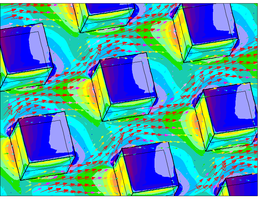Wind direction effects on urban flows
- Started
- 1st October 2007
- Ended
- 31st March 2011
- Research Team
- Jean Claus
- Investigators
- Zheng-Tong Xie, Ian Castro

Mean pressure distribution on ground and building-like obstacles and mean velocity vectors in mid-height plan for a 45º wind.
Motivation
Improving our understanding of air flows within cities is crucial for numerous fields such as pollution dispersion, parameterisation of weather forecasting and climate prediction models, wind loadings on buildings, pedestrian comfort and many more. Confronted with a wide variety of urban landscapes and in an effort to extract general characteristics of urban flows, recent research has been conducted on simple models of an urban canopy: e.g. staggered arrays of uniform or random height cuboids. In order to bridge the gap between this model and real urban canopies, more parameters need to be introduced. In this project we aim at clarifying the effects of different wind directions on the flow above and within the canopy.
Method
We are particularly interested in the velocity and pressure distributions, the drag force on the buildings and the logarithmic part of the streamwise velocity profile. However, just as most environmental flows, urban air flows are turbulent – their velocity and pressure fluctuate chaotically in time and space. Numerical simulations of such flows are notoriously demanding in computing power, especially when some – the largest if not all – scales of turbulence need to be resolved. For this project, large eddy simulations (LES) were conducted using CD-adapco’s commercial code StarCD. Each simulation required from 8 to 48 processors running simultaneously from 250 to 650 hours (10 to 30 days 24/7) making Iridis3 an ideal computing resource.
Findings
The results of the numerical simulations compared very well with the wind tunnel experiments conducted in parallel, giving us confidence in the findings. Although the mean flow within the lower part of the canopy showed only weak dependence on the direction of the wind aloft, the variations of the surface drag and of the parameters of the logarithmic law – non-linear and non-monotonic with the variation of wind angle – highlighted the importance of taking the wind direction into account when studying urban flows.
Acknowledgements
This work is funded by the Natural Environment Research Council (NERC) and the National Centre for Atmospheric Science (NCAS).
Categories
Physical Systems and Engineering simulation: CFD, Turbulence
Socio-technological System simulation: Built Environment
Algorithms and computational methods: Finite volume
Simulation software: StarCD
Software Engineering Tools: Emacs, Vim
Programming languages and libraries: Fortran
Computational platforms: Iridis, Linux, Windows
Transdisciplinary tags: Scientific Computing